Analysis of Gas Hydrate Growth Models
Master thesis
Permanent lenke
http://hdl.handle.net/11250/2416803Utgivelsesdato
2016-06-28Metadata
Vis full innførselSamlinger
Sammendrag
The kinetic behaviour of gas hydrate formation of pure methane have been studied and predicted based on different models. Experiments have been conducted at different temperatures and stirring rate, and the measured results have been closely examined and compared to the results produced by the models.
The experimental setup used in this thesis consist of a stirred cell reactor with a volume of 141.4 ml and with inner diameter of 60 mm, outer diameter of 90mm and a height of 50 mm. The cell is connected to a high pressure methane tank using a pressure reduction valve and a flow meter while being operated in open mode as to allow constant pressure supply of gas for the duration of the experiment.
Experiments were ran at 6, 7 and 8 ˚C and at stirring rates from 225 to 800 rpm. 50 ml of distilled water was used for all of the experiments.
The measured data on gas consumption, based on the amount of gas passing through the flow meter, as well as the heat released was used to estimate the hydrate growth rate. The start of each experiment is indicated by a rapid increase of temperature and gas consumption, and the end by the rotor blade either getting stuck in the hydrates, or reaching a constant power consumption due to pushing the hydrates aside. The growth period could be divided into three different growth stages, stage 1 representing the initial growth phase, stage 2 the mid-section and stage 3 the final section. Within each of this stages the growth rate can be approximately represented by a linear growth rate. The main focus in this thesis lies on growth stage 2.
Beskrivelse
Master's thesis in Petroleum engineering

